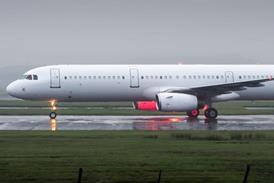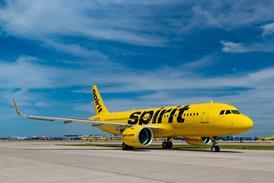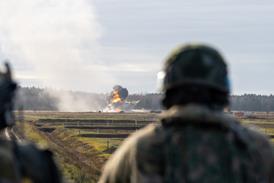The uncomfortable answer to high oil prices is for airlines to focus even more closely on costs and fuel efficiency
It is not hard to guess what weighed most on the minds of airline chief executives over the summer months - fuel prices. It was bad enough in the second quarter when crude oil moved above $35 a barrel and jet fuel above the $1 a US gallon mark. Carriers around the world were already issuing profit warnings.
But by early August, crude topped $40 a barrel and on 20 August West Texas Intermediate (WTI) - one of the five benchmark oil prices - closed just under $49.40 a barrel. What IATA director general Giovanni Bisignani dubbed the "fifth horseman of the apocalypse" in June was now riding rampant over the aviation industry.
The price eased in the last week of August, with WTI falling back to $42.28 a barrel, but what happens next is anyone's guess. It is possible to find an analyst to predict almost any future outcome for oil prices. For the optimists, $50 a barrel was a speculative bubble caused by hedge funds or investors looking for better returns in an era of low interest rates. The International Energy Agency even said the market was displaying "irrational exuberance". There seemed fairly widespread agreement at the time of the spike that up to $10 could be due to such speculation.
Underlying factors
On the other hand, the pessimists point to a range of underlying factors that could easily send oil prices up into the $50s and keep them there for a long period. A terrorist attack in Saudi Arabia, the collapse of the Yukos oil company in Russia, further troubles in Iraq, or an unusually cold winter in the USA could all send prices sky-rocketing. A bigger worry, however, is that this could be the start of a long-term squeeze on oil supplies. Factors here include a huge jump in demand from China - its oil imports were up 50% year-on-year in August, and its overall demand for oil rose 21% in the first half of 2004. The USA also saw demand rise 3.5% in the same period, fuelling the steepest rise in global demand for 24 years. And all this at a time when Opec producers are already using over 95% of their capacity. Opinions vary as to whether that leaves enough spare demand in the system, or whether there is enough new capacity coming online. On 24 August, for example, Opec revealed that its members drilled 6.5% fewer wells in 2003, which was seen by some as a sign of a prolonged supply crunch for oil.
The doomsters even say this could be a permanent end to the era of cheap energy. Optimists counter that any one of these factors could soon unravel - through a slowdown in the Chinese economy, for example. More worryingly, economists say high prices will soon start to choke off economic growth, and so lower demand.
Amid this cacophony of opinions, how can airlines formulate a strategy? One probably safe assumption is that even if prices come down from their peaks, they are not going to return to their former low levels. "In the 1990s the median was in the $20s but it will be in the $30s going forward," says John Heimlich, chief economist at the Air Transport Association, representing the views of US majors. "That is the difference between this and past spikes. Our fuel price forecast for the year is now $39, and even without the risk premium, it only goes back to $37."
That figure of $37 may sound a relatively benign price after the August highs, but it is worth remembering Bisignani's widely quoted remark in June that at $33 a barrel the airline industry breaks even, and for every extra dollar added to the price thereafter, it loses $1 billion. That is not what an industry that, according to the latest Airline Business ranking of the top 150 airline groups, made a net loss of $6.7 billion in 2003, needs to hear.
Just how big a hole higher oil prices can make in already thin airline margins was shown by the second-quarter results season. In its results for the quarter to June, British Airways said fuel costs could rise by £225 million ($405 million) - 22% - in the coming financial year, an amount twice its net profit for 2003 of $221 million, and not far behind the £300 million in staff costs it wants to save between now and 2006. In the same quarter, $232 million in extra fuel costs slashed profits at American Airlines to just $6 million and Lufthansa saw a €124 million rise in fuel costs produce a €23 million loss.
Faced with such depressing figures, what can airlines do? Hedging has certainly helped some carriers. The prime example is Southwest Airlines, which is 80% hedged for 2004 and 2005, with an average cost of 81.1c/gal. Andrew Sentance, chief economist at British Airways, says the carrier is 72% hedged until March at a price equivalent to $32 a barrel. Air France is also 70% hedged, and Lufthansa 90%, which it says saved it €90 million in the first half. All three carriers are hedged for about half that level in 2005.
The picture for the US majors is much less cheerful. The problem with hedging is that carriers that are struggling financially generally cannot afford - or get credit - to do it. So Delta Air Lines liquidated all its hedges in February, and United Airlines is also unhedged. Northwest and US Airways are about 20% hedged, according to Merrill Lynch, and American 15%. Estimated fuel costs per gallon for 2004 for these carriers ranges from 103.9c for Delta to 113.3c for American.
Price volatility
Hedging also has a limited shelf life: if prices stay high, all carriers will have to pay the higher price sooner or later. "Hedging is not the same as fuel saving," points out Heimlich. "Its principal benefit is to reduce price volatility." Chris Tarry of the CTAIRA consultancy adds: "Hedging should not be used to make a gamble on the market."
US carriers are no luckier in the matter of fuel surcharges. American tried on 30 July to impose a $5 per leg surcharge, but was forced to rescind it a few days later due to competitive pressure from low-cost carriers. "Pricing power in the US market is nil at present," says Heimlich. "A fuel surcharge is a price increase under another name. Customers are looking at the total cost of the trip."
In Europe and Asia, the situation has been easier. British Airways was the first to impose a £2.50 ($4) per leg fuel surcharge on all flights in May, soon followed by Virgin Atlantic, Air France, Cathay Pacific, Qantas, Singapore Airlines and a clutch of others. Not only have the surcharges held, but BA was even able to increase the long-haul one to £6 in August. "The industry as a whole is facing an increase in costs that it can't avoid, and over time that has to be reflected in higher prices to some degree," says Sentance.
BA can make surcharges stick because it is not suffering from the overcapacity on long-haul routes that the US carriers have in their domestic market. But even the fact that its key low-cost competitors on short-haul routes - Ryanair and EasyJet - have not imposed surcharges does not worry Sentance. "Our view is that profitability is important, not market share," he says, although he also admits advertised lead-in fares have been left without surcharges as a competitive measure. Sentance cannot resist a dig at the low-cost carriers as well, pointing out: "There are a range of surcharges imposed by carriers and they are not just confined to fuel. Some carriers impose surcharges for the use of credit cards."
The US market is a unique case and Tarry reckons the European experience will probably be more typical. "All carriers will put surcharges on because there is no competitive business advantage in not doing it," he says. "In cargo it has become routine, and it has to become the same in the passenger market."
Cargo does indeed provide a model that the passenger business might copy. Here many airlines have for years been systematically raising or lowering surcharges according to the fuel price. The acknowledged standard is Lufthansa Cargo, whose fuel index, based on an average of the five world spot prices, has been displayed each week on its website since August 2001, and which triggers surcharges in 5c/kg steps. As of late August, the index was close to triggering the highest 30c/kg surcharge.
Anti-trust issues come into play here, but Edward Hernandez, senior vice-president sales and marketing for US cargo carrier Polar Air Cargo, admits that the Lufthansa index "is a tool that the industry accepts and is used as a benchmark by many of our customers". He thinks the mentality of cargo customers has changed since 9/11. "They used to kick and scream about surcharges, but now they just accept them."
Slashing costs
But even surcharges cover only part of extra fuel costs, and they still leave many carriers facing a big hit on their costs. So is there anything else carriers can do? For IATA, the high fuel price only reinforces Bisignani's message at the association's annual general meeting in Singapore in June about the need to further slash costs. "There is nothing we can do about the fuel price, so we obviously have to look at removing inefficiencies," says IATA's Anthony Concil. "Last year it was SARS, this year it is fuel, and next year it will be something else. We have to make this industry more robust."
Ryanair provides an uncomfortable illustration of this. Unlike Southwest, it is hedged only until the end of September, but its combative boss Michael O'Leary professes to be unconcerned. One reason is he expects fuel prices to fall, but another is he believes Ryanair's cost structure can cope with the increase. "It is in our interests for oil prices to go higher," he said in August. "If the oil price doubles, we are going to see the end of a lot of loss-making airlines, but we will still squeak a profit."
That is a rather controversial way of putting it, but there seems a general consensus that redoubled cost-cutting is the only answer to higher fuel prices. "We need to improve labour productivity, sweat the assets, retire older aircraft," admits Sentance. Tarry adds: "This business is structurally unprofitable and still needs cost taking out. Airlines have already done a lot, but they need to do much more."
Concil also sees something of a silver lining in the current high fuel price, in that it might help to persuade third parties to be more co-operative on issues such as air traffic control delays, operational procedures at individual airports, and the lack of harmonisation between different national security regimes.
"The high price of fuel is an opportunity to put our case forward in such areas," he says. "There is a lot of scope for savings. For example, I know of one airport where an approach procedure adds 20 minutes to most flights. Multiply that by 400 flights a day, 365 days a year and it adds up to a lot of savings. Delays in the air also harm the environment and annoy customers, so if we can solve them it would be a win-win solution."
On security, Concil notes: "Three years after 9/11, we are still not seeing harmonisation and efficient use of resources. The fuel crisis is an opportunity to remind governments that we are not an industry that can afford to use resources inefficiently."
Heimlich at the ATA also thinks much more could be done in fuel efficiency. He points to such ideas as taxiing with one engine, using lower cruise speeds, and looking afresh at on-board weight. "In the good times, entertainment systems or heavier flat beds were added to aircraft because they increased revenue. Now carriers are looking harder at these things."
Fuel efficiency
The ATA estimates that fuel efficiency rose among US carriers by 13% between 2000 and 2003 - a bigger jump than in any equivalent period since it started tracking it. IATA says fuel efficiency rose 15.7% globally between 1994 and 2003. Its goal is a 10% increase between 2000 and 2010, and it reckons a 9% rise could come from ATC improvements and 6% from operational measures. At BA, which is targeting a 30% improvement in fuel efficiency between 1990 and 2010, Sentance adds: "The higher the oil price, the bigger incentive airlines will have for such programmes."
IATA is also looking at other ways to help airlines. In late August it was considering whether to issue them with advice on best fuel practice, and is also looking at how it could help carriers get the resources to hedge. "This industry does not have the best credit rating, and IATA handles a lot of money in settlements, so we are looking at whether we can use that to help airlines hedge," says Concil. But he stresses that such proposals are so far only at the exploratory stage.
REPORT BY PETER CONWAY IN LONDON
Source: Airline Business























